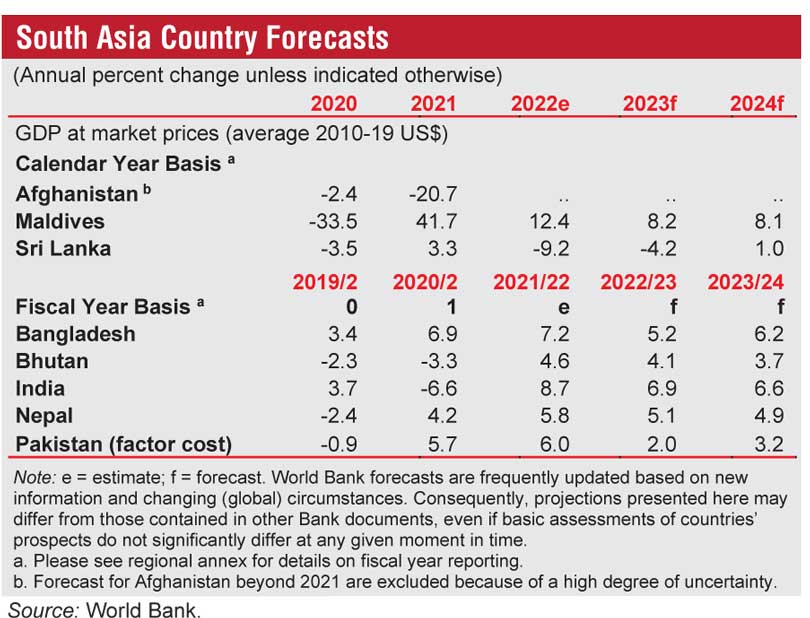Friday Mar 21, 2025
Friday Mar 21, 2025
Saturday, 14 January 2023 01:21 - - {{hitsCtrl.values.hits}}

The World Bank forecasts Sri Lanka to revert to a positive economic growth only in 2024.
The latest forecast of 1% growth was revealed in the World Bank’s Global Economic Prospects latest publication released this week.
The positive growth forecast in 2024 comes on the back of 4.2% contraction of the economy this year on top of record 9.2% shrinkage in 2022.
According to the World Bank, Sri Lank will remain the only South Asian economy to suffer contraction in 2022 and 2023. Bangladesh 2022 growth forecast is 5.2% in 2022/23 and 6.2% in 23/24. India’s growth is 6.9% and 6.6% in 22/23 and 23/24. Pakistan’s figures are 2% and 3.2% respectively.
The World Bank’s Global Economic Prospects report said that the economies of the South Asia region (SAR) continue to be adversely affected by shocks emanating from the Russian Federation’s invasion of Ukraine, including higher food and energy prices, and by the tightening of global financial conditions as central banks in the region and elsewhere act to fight high inflation.
Several economies, however, maintained resilient growth despite the global economic backdrop. In India, which accounts for three-fourths of the region’s output, growth expanded by 9.7% on an annual basis in the first half of fiscal year 2022/23 (April-March), reflecting strong private consumption and fixed investment growth. In Maldives, tourism rebounded robustly in 2022, returning its GDP to its pre-pandemic levels more quickly than previously expected; growth for the year is expected to be 12.4%.
Other economies faced difficult domestic developments and global spill-overs. Bangladesh was priced out of global energy markets and unable to meet the energy needs of households and businesses leading to blackouts and factory closures. In Sri Lanka, output is estimated to have fallen by 9.2% in 2022 as the Government ran out of the foreign exchange needed to cover food and fuel imports, and to service external debt.
In Afghanistan, the sudden pause of international aid in August 2021─ the foundation of economic activity for much of the preceding two decades─ is estimated to have an accumulated contraction of output between 2021 and 2022 of about one-third, leading to a large increase in poverty.
Outlook: Growth in SAR is projected to slow to 5.5% in 2023, from 6.1% the previous year, on slowing external demand and tightening financial conditions, before picking up slightly to 5.8% in 2024. Growth is revised lower over the forecast horizon and is below the region’s 2000-19 average growth of 6.5%. This pace reflects still robust growth in India, Maldives, and Nepal, offsetting the effects of the floods in Pakistan and the economic and political crises in Afghanistan and Sri Lanka.
Growth in India is projected to slow to 6.9% in FY2022/23, a 0.6%age point downward revision since June, as the global economy and rising uncertainty will weigh on export and investment growth. India is expected to be the world’s fastest growing major economy.
Pakistan is forecast to grow at 2.0% in FY2022/23 (July-June), half the pace that was anticipated last June, and faces challenging economic conditions, including the repercussions of the recent flooding and continued policy and political uncertainty.
In Bangladesh, growth is expected to slow to 5.2% in FY2022/23 (July-June) due to rising inflation and its negative impact on household incomes and firms’ input costs, as well as energy shortages, import restrictions, and monetary policy tightening.
Risks to the regional growth outlook remain to the downside. Food insecurity is rising in the region which consumes about one-fifth of its calories from wheat products, houses more than one-third of the global poor, and where food accounts for a greater share of its consumption basket compared to other emerging and developing economies. Although global food price inflation appears to have subsided, risks of increased deprivation and inadequate nutrition remain elevated.
Climate change is a significant threat in the region. The recent floods in Pakistan are estimated to have caused damage equivalent to about 4.8% of GDP. Extreme weather events can exacerbate food deprivation, cut the region off from essential supplies, destroy infrastructure, and directly impede agricultural production.
Discover Kapruka, the leading online shopping platform in Sri Lanka, where you can conveniently send Gifts and Flowers to your loved ones for any event including Valentine ’s Day. Explore a wide range of popular Shopping Categories on Kapruka, including Toys, Groceries, Electronics, Birthday Cakes, Fruits, Chocolates, Flower Bouquets, Clothing, Watches, Lingerie, Gift Sets and Jewellery. Also if you’re interested in selling with Kapruka, Partner Central by Kapruka is the best solution to start with. Moreover, through Kapruka Global Shop, you can also enjoy the convenience of purchasing products from renowned platforms like Amazon and eBay and have them delivered to Sri Lanka.
Discover Kapruka, the leading online shopping platform in Sri Lanka, where you can conveniently send Gifts and Flowers to your loved ones for any event including Valentine ’s Day. Explore a wide range of popular Shopping Categories on Kapruka, including Toys, Groceries, Electronics, Birthday Cakes, Fruits, Chocolates, Flower Bouquets, Clothing, Watches, Lingerie, Gift Sets and Jewellery. Also if you’re interested in selling with Kapruka, Partner Central by Kapruka is the best solution to start with. Moreover, through Kapruka Global Shop, you can also enjoy the convenience of purchasing products from renowned platforms like Amazon and eBay and have them delivered to Sri Lanka.